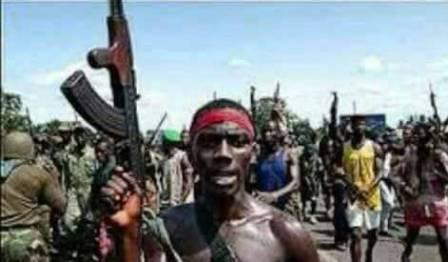“The Untold Story of Sierra Leone’s political Turmoil”
WHY AND HOW FREETOWN WAS INVADED ON JANURARY 6
a) The Poor Leadership Provided by SLPP
The serious setbacks faced by ECOMOG troops in the countryside climaxed by the January 6 invasion of Freetown are part of the untold stories to be told in the “Untold Story of Sierra Leone’s Political Turmoil”.
The drastic deterioration of the security situation barely a year after the beating of the AFRC/RUF military junta from Freetown was as a result of both political and military blunders. The reversal of the coup and the reinstatement of the democratically elected Government of President Ahmad Tejan Kabbah neither meant a defeat of the AFRC nor did it signal an end of the war.
The priority of the Government of Sierra Leone was to make a mass recruitment of troops to capitalize on the gains made by ECOMOG after the rebels had been weakened and sent in disarray. The rebels were to be pursued until their capacity to make nuisance was seriously weakened.
This was not the case. Recruitments took place at a snail’s pace and the Government’s management of security was below average. The SLPP administration also provided an extremely poor leadership. As the war raged in the countryside, the Government tried to fight the war through cheap political propaganda. Pieces of information put out by the Government on the prevailing security were grossly erroneous and misleading.
As the rebels overran ECOMOG troops from the country to Waterloo, the Government put out a jingle to dispel rumours of an imminent attack on Freetown. The jingle was entitled “Dem de kam”. ‘’Yu timap, dem de kam. Wu da de kam? You timap dem de kam’’. At the end of the jingle, the rumour was then dismissed as a mere tyre fire at Cline Town. The SLPP administration kept toying with the security of the state until the rebels invaded the capital on January 6, 1999 killing an estimated 6000 persons in cold blood.
I was among graduating students on 18 December 1998, when the President announced at the graduation ceremony that “the backbone of the rebels had been broken” only for the capital to be invaded two weeks later. The poor reading of the security situation by the Government was a major cause for concern. Its failure to take its responsibilities to ensure the safety and security of the people speak volumes about the quality of the leadership provided the SLPP administration which was perceived to be elitist.
One of the main tactics adopted by the rebels was the use of civilians as human shields as they advanced on Freetown on that fateful night of January 6. A good number of ECOMOG soldiers were killed. Some of the civilians made complicity with the rebels. Civilians found themselves between the devil and the deep sea. They became targets for both the rebels and ECOMOG. Civilians who lost their lives were killed by both the rebels and ECOMOG who considered any civilian as a rebel or traitor.
After the invasion of Freetown, the Government was still unable to correct its cheap propaganda machine. Freetown was still in the hands of rebel forces when the Information Minister told the BBC that the entire capital had been cleared of rebels and that ECOMOG troops were merely doing mop-up operations outside Freetown. The SLPP leadership spent more time in delivering speeches than in dealing with the security situation.
Gullible civilians who were still behind rebel lines in Calaba Town and Wellington came out only to be killed like flies while attempting to flee to the West of Freetown which was the only safe haven the capital. Two Ministers, Hon. M B Sesay and Dr. Y M Kromah who had gone to look out for some relatives at Goodrich Street were captured and slaughtered. The two ministers were humiliated, tortured before they were slaughtered by the rebels.
Another fatal mistake made by the Government and ECOMOG was the period of grace observed after the signing of a ceasefire agreement by mid 1999 when the rebels had been flushed out of Freetown and some parts of the countryside. The rebels used the ceasefire period to strengthen their positions and procure more weapons with support from Charles Taylor. Though nobody knew what was happening beyond the rebel lines, they were taken by their word until they had grown in numbers.
b) Lack of Commitment by ECOWAS
Of the 15 countries that make up ECOWAS, only three countries, namely Nigeria, Guinea and Ghana committed and maintained their troops in Sierra Leone throughout the war. Other countries like Mali and Senegal were quick to withdraw their troops when their positions were attacked by the rebels killing and wounding some of them.
As far as I know, the participation of Ghana and Guinea was merely symbolic. The Guineans at least defended their positions when attacked and they pursued the rebels when they crossed over to Guinea. With this strategy, the Guineans occupied Kambia town and Yenga a long time.
The Ghanaians would not deploy outside Freetown. The Nigerians handed over liberated areas to the Ghanaians to deploy within Freetown. The Ghanaians spent more time in decorating their checkpoints but were never involved in any active combat operations.
In effect, the war was planned and fought by Nigeria camouflaged as ECOMOG. However, like I have already pointed out, Nigeria needed the nominal presence of the Guineans and Ghanaians for the military inventions in Sierra Leone to have a West African outfit.
ECOWAS paid a lip service to the Government and people of Sierra Leone. While the fact remains that Nigeria had superior fire power over the AFRC/RUF rebels, it did not have the necessary man- power and resources to deploy and hold the entire country for a long period of time.
I accompanied ECOMOG in a number of visits to the countryside after the reinstatement of President Kabbah. In Kambia town, for instance, I saw less than a handful of ECOMOG soldiers deployed in the town. Though not a military expert, I had no iota of doubt that the soldiers were too thin to be able to respond to any major rebel assaults. Gen. Khobe once told me that the thin deployed of ECOMOG troops across the country was the main factor that provoked the troops’ major setbacks.
How could ECOWAS have authorized a military intervention without committing the required troops and resources? Why did ECOWAS leave Nigeria to undertake the whole operations alone? Why did the international community leave Nigeria to strand in Sierra Lone like fish on desert?
It was against this extremely fragile security situation coupled with the poor leadership provided by the SLPP that ECOMOG troops were beaten until Freetown was invaded on January 6, 1999.
Nigeria had to send more troops from the Rapid Intervention Force (RIF) to beat back the rebels. From the Lungi International Airport outside Freetown, the Nigerian troops were airlifted by helicopter to the Wilberforce Barracks from where they descended on the city.
According to Gen. Khobe, as ECOMOG advanced with support from loyalist troops from the Sierra Leone Army, two soldiers went down at the same time at at Sani Abacha Street, not far from the East End Police Station during an intensive exchange of fire. The fallen soldiers were Junior Sawaneh of the Sierra Leone Army and Major Aroh, the ECOMOG paymaster. Junior Sawaneh was shot on the chest while Maj. Aroh was hit by a bullet on the leg. He bled to death at the Wilberfoce Military hospital.
In the queue waiting for my turn before the amputation queue in Wellington… How I narrowly survived!
More on my personal experiences being behind rebel lines at the East End of Freetown.
Stay with Sierra Express Media, for your trusted place in news!
© 2014, https:. All rights reserved.




